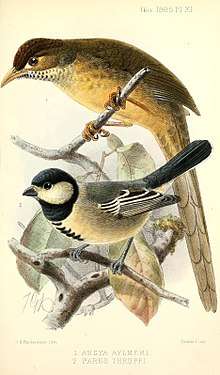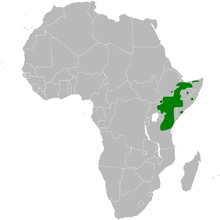Acacia tit
The acacia tit (Melaniparus thruppi), also known as the Somali tit and northern grey tit, is a species of bird in the family Paridae. It is native to north eastern Africa where it occurs in dry acacia habitat.
| Acacia tit | |
|---|---|
 | |
| (lower foreground) | |
| Scientific classification | |
| Kingdom: | Animalia |
| Phylum: | Chordata |
| Class: | Aves |
| Order: | Passeriformes |
| Family: | Paridae |
| Genus: | Melaniparus |
| Species: | M. thruppi |
| Binomial name | |
| Melaniparus thruppi | |
 | |
| resident range[3] | |
| Synonyms | |
|
Parus thruppi <small<Shelley, 1885 | |
Description
The smallest of the grey Melaniparus tits of Africa, the acacia tit has a glossy blue-black cap, nape, throat and breast contrasting with a large buffy white patch which extends from the bill to the sides of the neck. There is a broad black band which stretches from the breast to the vent. The upperparts are grey with white panels in the wings and there is a white spot on the nape. The underparts are greyish white, broken by the black band. Legs and bill are slate grey. The females tend to have a narrower band than males. Juveniles are similar to the adults but are duller.[4][5] It measures 11.5–12 cm in length and weighs 12g.[6]
Distribution and habitat
The acacia tit is found from Ethiopia and Somalia south to north eastern Tanzania.[6]
The acacia tit inhabits arid and semi arid wooded and bushed savanna, principally in acacia and stands of trees along streams or rivers, avoiding truly arid regions. Recorded up to 2000m in Somalia.[5]
Habits
The acacia tit is found in pairs or small parties and occasionally joins mixed species foraging flocks.[5] The food consists of small invertebrates, principally wasps, beetles and caterpillars.[6] It nests in holes in trees and one nest found had been predated by a snake but otherwise the habits and ecology of this species are poorly known.[5]
Taxonomy
The acacia tit was formerly one of the many species in the genus Parus but was moved to Melaniparus after a molecular phylogenetic analysis published in 2013 showed that the members of the new genus formed a distinct clade.[7][8] It forms a superspecies with the southern grey tit and probably also the miombo tit and ashy tit.[6] All of these species have been treated a sconspecific with the Palearctic great tit but they are not now thought to be closely related to that species.[5]
References
- BirdLife International 2012. Parus thruppi. Archived 2015-02-24 at the Wayback Machine The IUCN Red List of Threatened Species. Version 2014.3. Downloaded on 26 March 2015.
- "Parus thruppi Shelley, 1885". Integrated Taxonomic Information System (ITIS) (https://www.itis.gov). Archived from the original on 2016-11-07. Retrieved 2016-11-06.
- Based on maps in the Handbook of the Birds of the World and the BirdLife data zone
- Zimmerman, Dale A.; Turner, Donald A.; Pearson, David J. (1996). Birds of Kenya and Northern Tanzania. Helm. p. 595. ISBN 0-7136-3968-7.
- Harrap, Simon; Quinn, David (1996). Tits, Nuthatches and Treecreepers. London, UK: Christopher Helm. pp. 345–347. ISBN 0-7136-3964-4. Archived from the original on 2016-12-20.
- "Somali tit (Melaniparus thruppi)". Handbook of the Birds of the World. Lynx Edicions. Archived from the original on 2016-09-13. Retrieved 2016-11-06.
- Johansson, U.S.; Ekman, J.; Bowie, R.C.K.; Halvarsson, P.; Ohlson, J.I.; Price, T.D.; Ericson, P.G.P. (2013). "A complete multilocus species phylogeny of the tits and chickadees (Aves: Paridae)". Molecular Phylogenetics and Evolution. 69 (3): 852–860. doi:10.1016/j.ympev.2013.06.019. PMID 23831453.
- Gill, Frank; Donsker, David (eds.). "Waxwings and their allies, tits & penduline tits". World Bird List Version 6.1. International Ornithologists' Union. Archived from the original on 19 February 2016. Retrieved 15 February 2016.
- "Acacia tit Melaniparus thruppi Shelley, 1885". Avibase. Denis Lepage. Archived from the original on 2016-04-10. Retrieved 2016-11-06.
